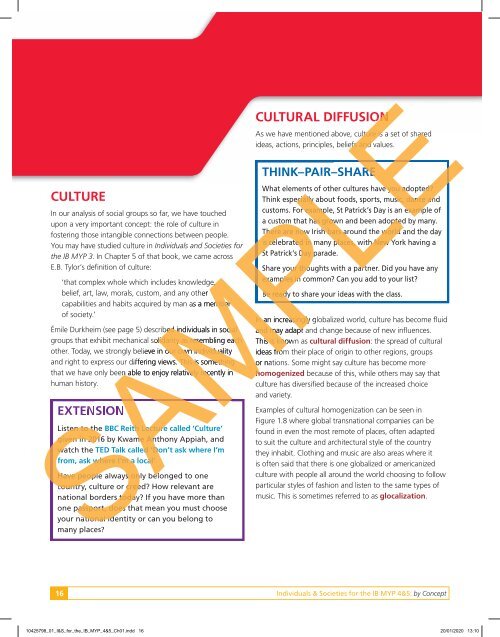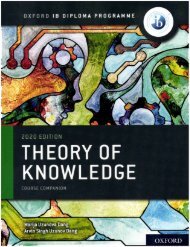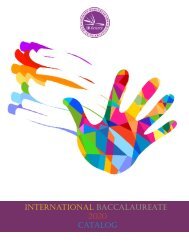Individuals-and-Societies-Sample
You also want an ePaper? Increase the reach of your titles
YUMPU automatically turns print PDFs into web optimized ePapers that Google loves.
CULTURE<br />
In our analysis of social groups so far, we have touched<br />
upon a very important concept: the role of culture in<br />
fostering those intangible connections between people.<br />
You may have studied culture in <strong>Individuals</strong> <strong>and</strong> <strong>Societies</strong> for<br />
the IB MYP 3. In Chapter 5 of that book, we came across<br />
E.B. Tylor’s definition of culture:<br />
‘that complex whole which includes knowledge,<br />
e,<br />
belief, art, law, morals, custom, <strong>and</strong> any other<br />
capabilities <strong>and</strong> habits acquired by man as a member<br />
mber<br />
of society.’<br />
Émile Durkheim (see page 5) described individuals in social<br />
groups that exhibit mechanical solidarity as resembling each<br />
other. Today, we strongly believe in our own individuality<br />
<strong>and</strong> right to express our differing views. This is something<br />
that we have only been en able to enjoy relatively recently in<br />
human history.<br />
EXTENSION<br />
Listen to the BBC Reith Lecture called ‘Culture’<br />
given in 2016 by Kwame Anthony Appiah, <strong>and</strong><br />
watch the TED Talk called ‘Don’t ask where I’m<br />
from, ask where I’m a local’.<br />
ideSAM Have people always only belonged to one<br />
country, culture or creed? How relevant are<br />
national borders today? If you have more than<br />
one passport, does that mean you must choose<br />
your national identity or can you belong to<br />
many places?<br />
CULTURAL DIFFUSION<br />
As we have mentioned above, culture is a set of shared<br />
ideas, actions, principles, beliefs efs <strong>and</strong> values.<br />
THINK–PAIR–SHAREARE<br />
What elements of other cultures ures have you adopted?<br />
Think especially ecially about foods, sports, music, dance <strong>and</strong><br />
customs. For example, St Patrick’s Day is an example of<br />
a custom that has grown <strong>and</strong> been adopted by many.<br />
There are now Irish bars around the world<br />
<strong>and</strong> the day<br />
is celebrated in many places, with New York having a<br />
St Patrick’s Day<br />
parade.<br />
Share your thoughts with a partner. Did you have any<br />
examples in common? Can you add to your list?<br />
Be ready to share your ideas with the class.<br />
In an increasingly<br />
globalized world, culture has become fluid<br />
<strong>and</strong> may adapt <strong>and</strong> change because of new influences.<br />
This is known<br />
as cultural diffusion: the spread of cultural<br />
ideas from<br />
their place of origin to other regions, groups<br />
or nations. Some might say culture has become more<br />
homogenized because of this, while others may say that<br />
culture has diversified because of the increased choice<br />
<strong>and</strong> variety.<br />
Examples of cultural homogenization can be seen in<br />
Figure 1.8 where global transnational companies can be<br />
found in even the most remote of places, often adapted<br />
to suit the culture <strong>and</strong> architectural style of the country<br />
they inhabit. Clothing <strong>and</strong> music are also areas where it<br />
is often said that there is one globalized or americanized<br />
culture with people all around the world choosing to follow<br />
particular styles of fashion <strong>and</strong> listen to the same types of<br />
music. This is sometimes referred to as glocalization.<br />
SAMPL<br />
MPLE E<br />
16<br />
<strong>Individuals</strong> & <strong>Societies</strong> for the IB MYP 4&5: by Concept<br />
10425798_01_I&S_for_the_IB_MYP_4&5_Ch01.indd 16 20/01/2020 13:10














